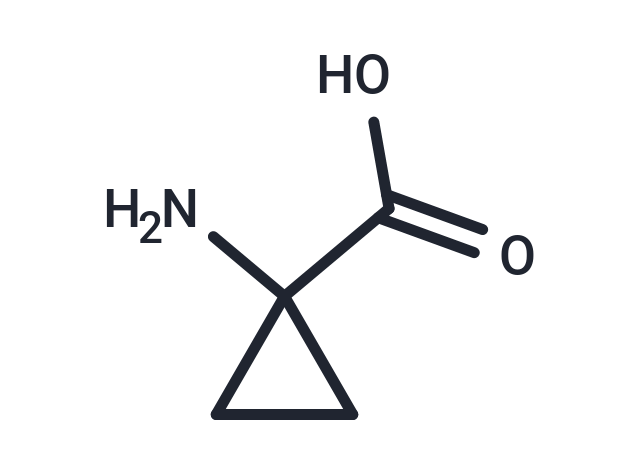- Remove All
 Your shopping cart is currently empty
Your shopping cart is currently empty
1-Aminocyclopropane-1-carboxylic acid
1-Aminocyclopropane-1-carboxylic acid (ACC) is an intermediate in the synthesis of ethylene, the plant hormone responsible for biological processes ranging from seed germination to organ senescence. It is a small molecule agonist at the glycine modulatory site of the NMDA receptor (EC50 = 0.7-0.9 μM) in the presence of low levels (1 μM) of glutamate and as a competitive antagonist at the glutamate-binding site on NMDA receptors (EC50 = 81.6 nM) with high levels (10 μM) of glutamate.2 This compound has been reported to protect against neuron cell death in vivo models of ischemia by enabling moderate levels of NMDA receptor activation and attenuating any excess NMDA receptor signaling that may lead to neurotoxicity.

1-Aminocyclopropane-1-carboxylic acid
| Pack Size | Price | Availability | Quantity |
|---|---|---|---|
| 100 mg | $30 | In Stock | |
| 500 mg | $46 | In Stock | |
| 1 g | $68 | In Stock |
Product Introduction
| Description | 1-Aminocyclopropane-1-carboxylic acid (ACC) is an intermediate in the synthesis of ethylene, the plant hormone responsible for biological processes ranging from seed germination to organ senescence. It is a small molecule agonist at the glycine modulatory site of the NMDA receptor (EC50 = 0.7-0.9 μM) in the presence of low levels (1 μM) of glutamate and as a competitive antagonist at the glutamate-binding site on NMDA receptors (EC50 = 81.6 nM) with high levels (10 μM) of glutamate.2 This compound has been reported to protect against neuron cell death in vivo models of ischemia by enabling moderate levels of NMDA receptor activation and attenuating any excess NMDA receptor signaling that may lead to neurotoxicity. |
| Targets&IC50 | NMDAR:0.7-0.9 µM (EC50) |
| Alias | ACC, 1-Aminocyclopropanecarboxylic acid, 1-Amino-1-carboxycyclopropane |
| Molecular Weight | 101.1 |
| Formula | C4H7NO2 |
| Cas No. | 22059-21-8 |
| Smiles | NC1(CC1)C(O)=O |
| Relative Density. | 1.414g/cm3 |
| Storage | Powder: -20°C for 3 years | In solvent: -80°C for 1 year | Shipping with blue ice. | ||||||||||||||||||||
| Solubility Information | H2O: 10 mM, Sonication is recommended. DMSO: Insoluble | ||||||||||||||||||||
Solution Preparation Table | |||||||||||||||||||||
H2O
| |||||||||||||||||||||
Calculator
In Vivo Formulation Calculator (Clear solution)
Dose Conversion
Tech Support
Keywords

Copyright © 2015-2025 TargetMol Chemicals Inc. All Rights Reserved.



